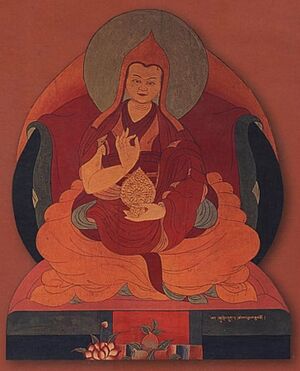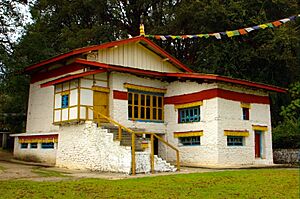6th Dalai Lama facts for kids
Quick facts for kids Tsangyang Gyatso |
|||||||
|---|---|---|---|---|---|---|---|
 |
|||||||
| Religion | Tibetan Buddhism | ||||||
| Personal | |||||||
| Born | 1 March 1683 Tawang (present-day Arunachal Pradesh, India) |
||||||
| Died | after 1706 (aged approx. 22-23) Amdo (reportedly survived Qing transport of 1706) |
||||||
| Senior posting | |||||||
| Title | 6th Dalai Lama | ||||||
| Period in office | 1697 received full authorities | ||||||
| Predecessor | Ngawang Lobsang Gyatso | ||||||
| Successor | Kelzang Gyatso | ||||||
| Chinese name | |||||||
| Chinese | 倉央嘉措 and 宕桑汪波 | ||||||
|
|||||||
| Tibetan name | |||||||
| Tibetan | ཚངས་དབྱངས་རྒྱ་མཚོ་ | ||||||
|
|||||||
Tsangyang Gyatso (Tibetan: ཚངས་དབྱངས་རྒྱ་མཚོ, Wylie: tshangs-dbyangs rgya-mtsho, ZYPY: Cangyang Gyamco) was the 6th Dalai Lama. He was born on March 1, 1683, and passed away after 1706. Tsangyang Gyatso was known for being different from other Dalai Lamas. He preferred a more ordinary life rather than being a traditional monk.
The death of the 5th Dalai Lama was kept a secret for many years. Tsangyang Gyatso was found when he was about 13 or 14 years old. He was born in a place called "Monyul," at Urgelling Monastery. This area is now known as Tawang district in Arunachal Pradesh, India.
As a young person, Tsangyang Gyatso was very smart. He had unique ideas and liked to live like a regular Tibetan. He grew his hair long and dressed in normal clothes. During a time of conflict between Tibet, Mongols, and China in Lhasa, the Dalai Lama's main advisor, called a regent, was killed. After this, Tsangyang Gyatso was taken by Mongol forces. He then disappeared in Amdo in 1706 while being taken to Beijing. Many people believed he was murdered.
Tsangyang Gyatso is also famous for his beautiful poems and songs. These writings are still very popular today in Tibet and among Tibetan communities in Nepal, India, and China.
Contents
Early Life of Tsangyang Gyatso

Tsangyang Gyatso was born on March 1, 1683, in a place called Mon Tawang. This area is now part of Arunachal Pradesh, India. His father was Lama Tashi Tenzin from Urgelling Monastery. His mother was Tsewang Lhamo, a woman from the Monpa people.
This means the Dalai Lama belonged to the Monpa people. He was born in "Monyul," near Tawang and Tawang Monastery.
There were special stories about Tsangyang Gyatso's birth. His mother, Tsewang, experienced some unusual things before he was born. One day, while she was preparing rice, water started to fill the stone bowl she was using. Another time, when Tsewang drank water from a stream, milk came out instead of water. Because of this, the stream became known as Oma-Tsikang, which means "milky water."
When Tsangyang was born, he was first named Sanje Tenzin. Later, his face swelled from an infection, and he could barely open his eyes. Two local wise people were called. They said his name should be changed to Ngawang Gyatso.
His recovery was believed to be due to the help of the Dalai Lama's special protector, Dorje Dakpa. His grandfather had a dream that heavenly beings were always protecting the child. His mother dreamt that many people came to take him away. His grandmother dreamt of two suns shining in the sky.
Becoming the Dalai Lama
The 5th Dalai Lama had passed away in 1682. However, his main advisor, Desi Sangye Gyatso, kept his death a secret for many years. He did this to keep the government stable and to finish building the Potala Palace. Monks searched for the next Dalai Lama in Tibet. They later realized the 6th Dalai Lama was born outside Tibet, in a valley ending with "ling." They searched places like Urgyanling, Sangeling, and Tsorgeling in Tawang.
In 1697, the Potala authorities took Tsangyang Gyatso from his mother at Urgyanling. The journey to Lhasa took seven days. They spent their first night in Tsona. After arriving in Tibet, Sangye Gyatso told the Kangxi Emperor of China that the 5th Dalai Lama had died and the 6th had been found.
The regent invited Lobsang Yeshe, 5th Panchen Lama to give the young man his first monk vows. This happened at Nankartse, and he was named Tsang Gyatso. On December 8, 1697, Tsangyang Gyatso officially became the 6th Dalai Lama.
In 1705, Lha-bzang Khan, a Mongol king, had the regent, Sangye Gyatso, killed. This made the young Dalai Lama very upset. He stopped his studies and even went to the 5th Panchen Lama to give up his monk vows.
Life as a Unique Dalai Lama
As the Dalai Lama, Tsangyang wrote many wonderful songs and poems. However, he often did things that went against the rules of the Gelug School of Tibetan Buddhism. For example, he decided to only take the vows of a novice monk, called getsul vows, at age eighteen. He chose not to take the full monk vows, called gelong vows, which was normal for his age.
The Panchen Lama and Prince Lhazang tried to convince him to take the full vows, but he refused.
Tsangyang Gyatso visited the 5th Panchen Lama in Shigatse and gave up his novice monk vows. He ordered the building of the Tromzikhang palace in Barkhor, Lhasa.
Tsangyang Gyatso never wanted to live the life of a strict monk. However, he did not give up his position as the Dalai Lama. He wore normal clothes and preferred to walk instead of riding a horse or using the special state carriage. Tsangyang only kept the political duties of the Dalai Lama. He even lived in a tent in a park near the Potala Palace. In 1702, Tsangyang stopped giving public talks, which he was supposed to do as part of his training.
Capture and Disappearance
Using the Dalai Lama's unusual behavior as an excuse, and with the support of China's Kangxi Emperor, Lha-bzang Khan, a Mongol leader, killed the regent and took the Sixth Dalai Lama. On June 28, 1706, Lha-bzang Khan removed Tsangyang from his position. In 1707, he put a 21-year-old lama named Ngawang Yeshey Gyatso in place, claiming he was the "true" 6th Dalai Lama. The Gelugpa leaders and the Tibetan people did not accept Ngawang Yeshey Gyatso. They continued to see Tsangyang as the real Dalai Lama.
While being taken out of Tibet, Tsangyang wrote a poem. Some people believe this poem predicted his next birth. It said: "White crane lend me your wings. I will not fly far. From Lithang I shall return." Tsangyang mysteriously disappeared near Qinghai on November 15, 1706. This is why there is no tomb for him in the Potala Palace.
Rumors said that he had escaped and was living secretly somewhere between China and Mongolia. A writing from 1757 even claimed that the Dalai Lama survived and was welcomed by a group of monasteries in Amdo.
The Tibetans asked the Dzungar people for help. The Dzungars invaded Tibet and killed Lha-bzang Khan in late 1717.
Tsangyang was later succeeded by Kelsang Gyatso, who was born in Lithang. Kelsang Gyatso became the 7th Dalai Lama.
See also
 In Spanish: Tsangyang Gyatso para niños
In Spanish: Tsangyang Gyatso para niños

